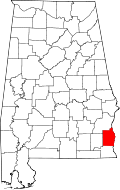Headland | |
|---|---|
 This statue of a World War I doughboy, with his arm outstretched, honors all of Headland's military dead. It stands at the center of Headland Public Square. | |
 Location of Headland in Henry County, Alabama. | |
| Coordinates: 31°21′12″N85°20′23″W / 31.35333°N 85.33972°W | |
| Country | United States |
| State | Alabama |
| County | Henry |
| Government | |
| • Mayor | Jody M. Singleton (R), 2025–present [1] |
| Area | |
• Total | 30.34 sq mi (78.58 km2) |
| • Land | 30.33 sq mi (78.56 km2) |
| • Water | 0.012 sq mi (0.03 km2) |
| Elevation | 385 ft (117 m) |
| Population (2020) | |
• Total | 4,973 |
| • Density | 164.0/sq mi (63.31/km2) |
| Time zone | UTC−6 (Central (CST)) |
| • Summer (DST) | UTC−5 (CDT) |
| ZIP code | 36345 |
| Area code | 334 |
| FIPS code | 01-33856 |
| GNIS feature ID | 0119910 |
| Website | www |
Headland is the largest city in Henry County, Alabama, United States. It is part of the Dothan metropolitan area. In 2020, the population was 4,973, up from 4,510 [3] in the 2010 census.




